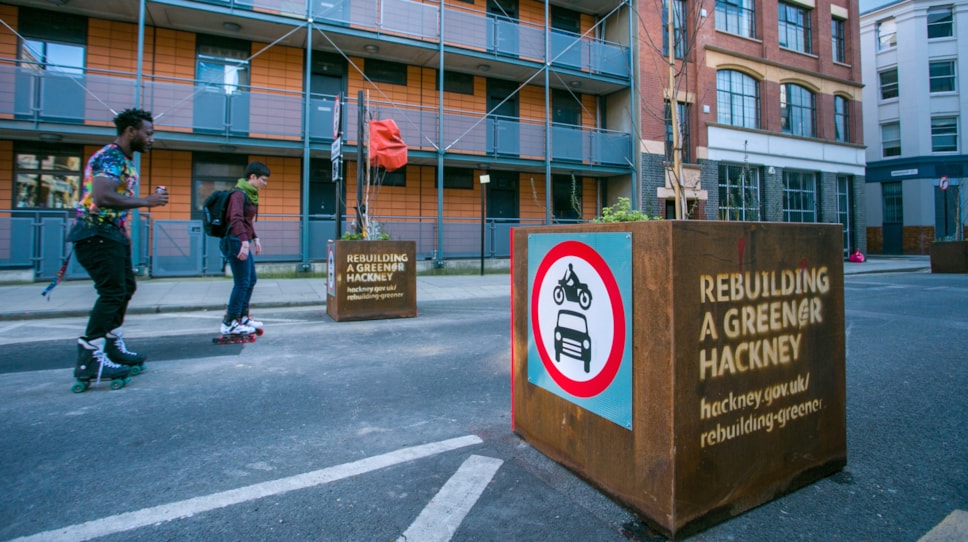
Rebuilding a Greener Hackney: residents encouraged to have their say
Residents are being encouraged to continue to have their say on Hackney’s new low traffic neighbourhoods, School Streets and cycle lanes, as the Council begins a new push to ensure the views of everyone in the borough are heard.
Over 12,000 responses have been received so far on schemes introduced under the Council’s plans to rebuild a greener Hackney in the wake of the pandemic.
However, with new low traffic neighbourhoods covering approximately 17% of Hackney’s population - approximately 50,000 people - and its new School Streets supporting over 14,000 children across 41 schools to walk and cycle to school, the Council wants to make sure everyone has the chance to have their say.
It is therefore extending the engagement period for its rebuilding a greener Hackney programme so residents can see how schemes operate as the capital emerges from lockdown, and to encourage as many people as possible to have their say.
The Council is sending a leaflet to all properties in the borough this week to encourage residents to have their say.
In addition to the engagement exercise, the Council is set to ask an independent polling company to speak to residents across the borough to ensure that a representative sample of residents’ views are heard.
It is also monitoring traffic levels in the borough - through analysis of Transport for London traffic monitors, spot-monitoring of over 200 sites during one week periods in November and spring, and by introducing its own network of fixed, real-time monitoring sites.
This data will then feed into an air quality model to show the effect of low traffic neighbourhoods on air pollution and highlight any areas where pollution could increase so the Council can take further action to mitigate this.
In response to comments from residents, the Council has made tweaks to schemes to ensure schemes work better, such as moving the filter on Nile Street in Hoxton and removing a series of banned turns near the London Fields LTN.
Last year’s trial low traffic neighbourhoods - aimed at supporting all residents to walk, shop and cycle locally - build on Hackney’s long history of traffic calming measures.
Its first low traffic neighbourhood was introduced in De Beauvoir in 1974, and, before last year’s introduction of low traffic neighbourhoods, there were already over 120 traffic filters across Hackney.
However, in the last seven years, the miles driven on Hackney’s roads has increased by 40 million, nearly all of which - according to London-wide Department for Transport statistics - has ended up on neighbourhood streets that are unable to cope with additional volumes of traffic.
In addition, Hackney Council’s own analysis of data shows that about 40% of traffic in the borough passes through without stopping, causing air pollution and congestion without providing any economic benefit to the borough.
Low traffic neighbourhoods are aimed at arresting this rise in traffic, and ensuring that Hackney residents have clean, pleasant neighbourhoods to walk, cycle and shop in locally.
Residents can have their say at rebuildingagreenerhackney.commonplace.is or by writing to ‘Freepost Streetscene’.
The engagement period on smaller schemes will start to close from 31 May.
Engagement with residents on larger schemes will continue for longer to ensure that residents have the opportunity to continue to have their say and the Council and our communities see how schemes operate as the capital emerges from lockdown. In support of this, the Council will continue to monitor and publish traffic data on these schemes.
Our trial low traffic neighbourhoods and School Streets have positively transformed large parts of the borough - creating quieter, greener streets for everyone and encouraging people to walk, shop and cycle locally during the pandemic and beyond.
We introduced these measures to support people as they spend more time in their local area during the pandemic, but also to protect them from rises in traffic levels in London shown in Department for Transport statistics.
I know that not all of our residents agree on their introduction, which is why we want to make sure all of Hackney’s diverse residents have their say. We’ll then look in detail at what people have told us, alongside traffic monitoring that shows the benefits and challenges of low traffic neighbourhoods and other measures, to see what further work we can do to respond to concerns and help mitigate some of the difficulties some people are reporting before making a decision on whether or not to make trial measures permanent.Philip Glanville, Mayor of Hackney
We’re passionate about rebuilding a greener Hackney for all of our residents and businesses and making sure that journeys on foot, by bike or by public transport are as safe and clean as possible - which is why we’ve introduced new low traffic neighbourhoods and School Streets across the borough.
However, we also know that not everyone can make that switch, which is why it’s so important that we have everyone’s feedback and can work together to help mitigate any negative impacts of these changes.
I want people to know that I’ll work with them on this - as we create a cleaner, greener borough for everyone.Cllr Mete Coban MBE, Cabinet Member for Energy, Waste, Transport and Public Realm
